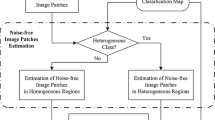Abstract
The KSVD algorithm has been a focus of image filtering research ever since it was first developed. However, this algorithm has a slow convergence rate for sparse coding, and dictionary updating via singular value decomposition is too complex. Consequently, the filtering efficiency is very low for large synthetic aperture radar images, and a significant amount of edge texture information is lost. To address these issues, this paper proposes a double iterative optimal dictionary (DIOD) learning algorithm. First, during the sparse coding process, a single iteration is performed to select the optimal and second most optimal dictionary atoms for representing the residual error, and the selected atoms are then updated according to the accumulation of dictionary coefficients. Next, the normalized and weighted reconstruction error is used to update the dictionary. The experimental results indicate that the DIOD algorithm provides better edge preservation and has better operational efficiency than the KSVD algorithm while maintaining a high peak-signal-to-noise ratio. This approach effectively avoids the repetitive occurrence of dictionary atoms in the iteration process, accelerates the convergence rate, and increases the sparsity of the sparse coding coefficients while simplifying the dictionary updating method, enabling rapid filtering of large synthetic aperture radar images, and achieving an improved filtering effect.




Similar content being viewed by others
References
Arsenault, H.H.: Speckle suppression and analysis for synthetic aperture radar images. Opt. Eng. 25(5), 636–643 (1986)
Lopes, A., Touzi, R., Nezry, E.: Adaptive speckle filters and scene heterogeneity. IEEE Trans. Geosci. Remote Sens. 28(6), 992–1000 (1990)
Kumar, B.K.S.: Image denoising based on non-local means filter and its method noise thresholding. Signal Image Video Process. 7(6), 1211–1227 (2013)
Sumaiya, M.N., Kumari, R.S.S.: SAR image despeckling using heavy-tailed Burr distribution. Signal Image Video Process. 11(1), 49–55 (2016)
Cui, H., Yan, G., Song, H.: A novel curvelet thresholding denoising method based on chi-squared distribution. Signal Image Video Process. 9(2), 491–498 (2015)
Tian, X., Jiao, L., Zhang, X.: Despeckling SAR images based on a new probabilistic model in nonsubsampled contourlet transform domain. Signal Image Video Process. 8(8), 1459–1474 (2014)
Perona, P., Malik, J.: Scale-space and edge detection using anisotropic diffusion. IEEE Trans. Pattern Anal. Mach. Intell. 12(7), 629–639 (1990)
Gomez, L., Munteanu, C., Jacobo-Berlles, J., et al.: Evolut- ionary expert-supervised despeckled SRAD filter design for enhancing SAR images. IEEE Geosci. Remote Sens. Lett. 8(4), 814–818 (2011)
Zhu, L., Zhao, X., Gu, M.: SAR image despeckling using improved detail-preserving anisotropic diffusion. Electron. Lett. 50(15), 1092–1093 (2014)
Olshausen, B.A., Field, D.J.: Emergence of simple-cell receptive field properties by learning a sparse code for natural images. Nature 381(6583), 607–609 (1996)
Sadeghi, M., Babaie-Zadeh, M., Jutten, C.: Learning overcomplete dictionaries based on atom-by-atom updating. IEEE T Image Process. 62(4), 883–891 (2014)
Zhang, A.Q., Fu, Y., Li, H., et al.: Dictionary learning method for joint sparse representation-based image fusion. Opt. Eng. 52(5), 7006 (2013)
Dikmen, O., FéVotte, C.: Maximum marginal likelihood estimation for nonnegative dictionary learning. Proc. Int. Conf. Acoust. Speech Signal Process. (ICASSP‘ 11) 60(10), 1992–1995 (2011)
Rubinstein, R., Zibulevsky, M., Elad, M.: Efficient Imple- mentation of the K-SVD Algorithm Using Batch Orthogonal Matching Pursuit. Cs Technion 40, 1–15 (2008)
Zheng, H., Bouzerdoum, A., Phung, S,L.: Depth image super-resolution using multi-dictionary sparse representation. IEEE International Conference on Image Processing (ICIP), pp 957–961 (2013)
Zdunek, R., Cichocki, A.: Improved M-FOCUSS algorithm with overlapping blocks for locally smooth sparse signals. IEEE Trans. Signal Process. 56(10), 4752–4761 (2008)
Sajjad, M., Mehmood, I., Baik, S.W.: Sparse coded image super-resolution using K-SVD trained dictionary based on regularized orthogonal matching pursuit. Bio-Med. Mater. Eng. 26(s1), 1399–1407 (2015)
Donoho, D.L., Tsaig, Y., Drori, I., et al.: Sparse solution of underdetermined systems of linear equations by stagewise orthogonal matching pursuit. IEEE Trans. Inf. Theory 58(2), 1094–1121 (2012)
Cen, Y., Wang, F., Zhao, R., et al.: Tree-based backtracking orthogonal matching pursuit for sparse signal reconstruction. J. Appl. Math. 2013(2), 1–8 (2013)
Elad, M., Aharon, M.: Image denoising via sparse and redundant representations over learned dictionaries. IEEE T Image Process. 15(12), 3736–3745 (2006)
Rubinstein, R., Zibulevsky, M., Elad, M.: Double sparsity: learning sparse dictionaries for sparse signal approximation. IEEE Trans. Signal Process. 58(3), 1553–1564 (2010)
Lu, T., Li, S., Fang, L., et al.: SAR image despeckling via structural sparse representation. Sens. Imaging 17(1), 1–20 (2016)
Luo, H., Chu, H., Xu, Y.: Clustering-based image sparse denoising in wireless multimedia sensor networks. Circ. Syst. Signal Process. 34(3), 1–14 (2015)
Yang, S., Zhao, L., Wang, M., et al.: Dictionary learning and similarity regularization based image noise reduction. J. Vis. Commun. Image Represent. 24(2), 181–186 (2013)
Acknowledgements
This project was supported by an Open Research Program of the Changjiang River Scientific Research Institute (Program SN: CKWV2016403/KY) and by the Beijing Research Institute of Uranium Geology (Program SN:RS HXY111-1). We would like to thank American Journal Experts (http://www.aje.com/) for producing the English language translation of this manuscript.
Author information
Authors and Affiliations
Corresponding author
Rights and permissions
About this article
Cite this article
Zhan, Y., Dai, T., Huang, J. et al. Double iterative optimal dictionary learning-based SAR image filtering method. SIViP 12, 783–790 (2018). https://doi.org/10.1007/s11760-017-1220-6
Received:
Revised:
Accepted:
Published:
Issue Date:
DOI: https://doi.org/10.1007/s11760-017-1220-6




